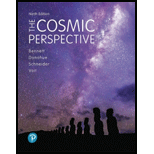
EBK THE COSMIC PERSPECTIVE
9th Edition
ISBN: 9780135161760
Author: Voit
Publisher: VST
expand_more
expand_more
format_list_bulleted
Textbook Question
Chapter 4, Problem 4VSC
Use the following questions to check your understanding of some of the many types of visual information used in astronomy. For additional practice, try the Chapter 4 Visual Quiz at MasteringAsrrononry®.

The figure above, based on figure 4.24, shows how the Moon causes tides on Earth. Note that the North Pole is in the center of the diagram, so the numbers 1 through 4 label points along Earth's equator.
4. What time is it at point l?
a. noon
b. midnight
c. 6 a.m.
d. cannot be determined from the information in the figure
Expert Solution & Answer
Want to see the full answer?
Check out a sample textbook solution
Students have asked these similar questions
Please solve and answer the question correctly please. Thank you!!
Please solve and answer the question correctly please. Thank you!!
solve and answer the question correctly please. Thank you!!
Chapter 4 Solutions
EBK THE COSMIC PERSPECTIVE
Ch. 4 - Prob. 1VSCCh. 4 - Use the following questions to check your...Ch. 4 - Use the following questions to check your...Ch. 4 - Use the following questions to check your...Ch. 4 - Use the following questions to check your...Ch. 4 - Define speed, velocity, and acceleration. What are...Ch. 4 - Define momentum and force. What do we mean when we...Ch. 4 - What is free-fall, and why does it make you...Ch. 4 - Prob. 4EAPCh. 4 - Describe the laws of conservation of momentum, of...
Ch. 4 - Define kinetic energy, radiative energy, and...Ch. 4 - Define temperature and thermal energy. How are...Ch. 4 - Prob. 8EAPCh. 4 - 9. Summarize the universal law of gravitation both...Ch. 4 - 10. What is the difference between a bound and an...Ch. 4 - What do we need to know if we want to measure an...Ch. 4 - Explain why orbits cannot change spontaneously,...Ch. 4 - Explain how the Moon creates tides on Earth. Why...Ch. 4 - What is tidal friction? What effects does it have...Ch. 4 - Does It Make Sense?
Decide whether the statement...Ch. 4 - Does It Make Sense?
Decide whether the statement...Ch. 4 - Does It Make Sense?
Decide whether the statement...Ch. 4 - Does It Make Sense?
Decide whether the statement...Ch. 4 - Prob. 19EAPCh. 4 - Prob. 20EAPCh. 4 - Does It Make Sense? Decide whether the statement...Ch. 4 - Does It Make Sense?
Decide whether the statement...Ch. 4 - Does It Make Sense?
Decide whether the statement...Ch. 4 - Does It Make Sense?
Decide whether the statement...Ch. 4 - Choose the best answer to each of the following....Ch. 4 - Choose the best answer to each of the following....Ch. 4 - Choose the best answer to each of the following....Ch. 4 - Choose the best answer to each of the following....Ch. 4 - Choose the best answer to each of the following....Ch. 4 - Prob. 30EAPCh. 4 - Prob. 31EAPCh. 4 - Choose the best answer to each of the following....Ch. 4 - Choose the best answer to each of the following....Ch. 4 - Choose the best answer to each of the following....Ch. 4 - Prob. 35EAPCh. 4 - Testing Gravity. Scientists are continually trying...Ch. 4 - Prob. 38EAPCh. 4 - Prob. 39EAPCh. 4 - Prob. 40EAPCh. 4 - Weightlessness. Astronauts are weightless when in...Ch. 4 - Units of Acceleration. If you drop a rock from a...Ch. 4 - Gravitational Potential Energy. For each of the...Ch. 4 - Prob. 44EAPCh. 4 - The Gravitational Law. How does quadrupling the...Ch. 4 - Allowable Orbits? Suppose the Sun were replaced by...Ch. 4 - Head-to-Foot Tides. You and Earth attract each...Ch. 4 - Prob. 48EAPCh. 4 - Geostationary Orbit. A satellite in geostationary...Ch. 4 - Prob. 51EAPCh. 4 - Prob. 52EAPCh. 4 - Moving Candy Bar. Table 4.1 shows that...Ch. 4 - Spontaneous Human Combustion. Suppose that all the...Ch. 4 - Fusion Power. No one has yet succeeded in creating...Ch. 4 - Understanding Newton’s Version of Kepler’s Third...Ch. 4 - Using Newton’s Version of Kepler’s Third Law....Ch. 4 - Escape Velocity. Calculate the escape velocity...Ch. 4 - Weights on Other Worlds. Calculate the...Ch. 4 - Prob. 60EAPCh. 4 - Extra Moon. Suppose Earth had a second moon,...
Knowledge Booster
Learn more about
Need a deep-dive on the concept behind this application? Look no further. Learn more about this topic, physics and related others by exploring similar questions and additional content below.Similar questions
- Please solve and answer the problem correctly please. Thank you!!arrow_forwardPlease solve and answer the problem correctly please.Thank you!!arrow_forwardProblem Eight. A snowmobile is originally at the point with position vector 31.1 m at 95.5° counterclockwise from the x-axis, moving with velocity 4.89 m/s at 40.0°. It moves with constant acceleration 1.73 m/s² at 200°. After 5.00 s have elapsed, find the following. 9.) The velocity vector in m/s. (A)=-4.38+0.185ĵ (D) = 0.185 +4.38ĵ (B)=0.1851-4.38ĵ (E) = 4.38 +0.185ĵ (C) v=-0.1851-4.38ĵ (A)=-39.3-4.30ĵ 10.) The final position vector in meters. (B)=39.3-4.30ĵ (C) = -4.61 +39.3ĵ (D) = 39.31 +4.30ĵ (E) = 4.30 +39.3ĵarrow_forward
- Problem Seven. A football receiver running straight downfield at 5.60 m/s is 11.5 m in front of the quarterback when a pass is thrown downfield at an angle of 35.0° above the horizon. 8.) If the receiver never changes speed and the ball is caught at the same height from which it was thrown, find the distance between the quarterback and the receiver when the catch is made. (A) 21.3 (B) 17.8 (C) 18.8 (D) 19.9 (E) 67.5arrow_forward3 Consider a ball sliding down a ramp as shown above. The ball is already in motion at the position 1. Which direction best approximates the direction of instantaneous velocity vector V when the object is at position 3?arrow_forwardNo chatgpt plsarrow_forward
- A car in a roller coaster moves along a track that consists of a sequence of ups and downs. Let the x axis be parallel to the ground and the positive y axis point upward. In the time interval from t 0 tot = = 4s, the trajectory of the car along a certain section of the track is given by 7 = A(1 m/s)ti + A [(1 m/s³) t³ - 6(1 m/s²)t²]ĵ where A is a positive dimensionless constant. At t car ascending or descending? = 2.0 S is the roller coaster Ascending. Descending.arrow_forwardneed help on first part its not 220arrow_forwardNo chatgpt pls will upvotearrow_forward
- No chatgpt plsarrow_forwardChildren playing in a playground on the flat roof of a city school lose their ball to the parking lot below. One of the teachers kicks the ball back up to the children as shown in the figure below. The playground is 6.10 m above the parking lot, and the school building's vertical wall is h = 7.40 m high, forming a 1.30 m high railing around the playground. The ball is launched at an angle of 8 = 53.0° above the horizontal at a point d = 24.0 m from the base of the building wall. The ball takes 2.20 s to reach a point vertically above the wall. (Due to the nature of this problem, do not use rounded intermediate values-including answers submitted in WebAssign-in your calculations.) (a) Find the speed (in m/s) at which the ball was launched. 18.1 m/s (b) Find the vertical distance (in m) by which the ball clears the wall. 0.73 ✓ m (c) Find the horizontal distance (in m) from the wall to the point on the roof where the ball lands. 2.68 m (d) What If? If the teacher always launches the ball…arrow_forwardIt is not possible to see very small objects, such as viruses, using an ordinary light microscope. An electron microscope can view such objects using an electron beam instead of a light beam. Electron microscopy has proved invaluable for investigations of viruses, cell membranes and subcellular structures, bacterial surfaces, visual receptors, chloroplasts, and the contractile properties of muscles. The "lenses" of an electron microscope consist of electric and magnetic fields that control the electron beam. As an example of the manipulation of an electron beam, consider an electron traveling away from the origin along the x axis in the xy plane with initial velocity ₁ = vi. As it passes through the region x = 0 to x=d, the electron experiences acceleration a = ai +a, where a and a, are constants. For the case v, = 1.67 x 107 m/s, ax = 8.51 x 1014 m/s², and a = 1.50 x 10¹5 m/s², determine the following at x = d = 0.0100 m. (a) the position of the electron y, = 2.60e1014 m (b) the…arrow_forward
arrow_back_ios
SEE MORE QUESTIONS
arrow_forward_ios
Recommended textbooks for you
 Foundations of Astronomy (MindTap Course List)PhysicsISBN:9781337399920Author:Michael A. Seeds, Dana BackmanPublisher:Cengage Learning
Foundations of Astronomy (MindTap Course List)PhysicsISBN:9781337399920Author:Michael A. Seeds, Dana BackmanPublisher:Cengage Learning Stars and Galaxies (MindTap Course List)PhysicsISBN:9781337399944Author:Michael A. SeedsPublisher:Cengage Learning
Stars and Galaxies (MindTap Course List)PhysicsISBN:9781337399944Author:Michael A. SeedsPublisher:Cengage Learning
 Horizons: Exploring the Universe (MindTap Course ...PhysicsISBN:9781305960961Author:Michael A. Seeds, Dana BackmanPublisher:Cengage Learning
Horizons: Exploring the Universe (MindTap Course ...PhysicsISBN:9781305960961Author:Michael A. Seeds, Dana BackmanPublisher:Cengage Learning
 Stars and GalaxiesPhysicsISBN:9781305120785Author:Michael A. Seeds, Dana BackmanPublisher:Cengage Learning
Stars and GalaxiesPhysicsISBN:9781305120785Author:Michael A. Seeds, Dana BackmanPublisher:Cengage Learning

Foundations of Astronomy (MindTap Course List)
Physics
ISBN:9781337399920
Author:Michael A. Seeds, Dana Backman
Publisher:Cengage Learning

Stars and Galaxies (MindTap Course List)
Physics
ISBN:9781337399944
Author:Michael A. Seeds
Publisher:Cengage Learning


Horizons: Exploring the Universe (MindTap Course ...
Physics
ISBN:9781305960961
Author:Michael A. Seeds, Dana Backman
Publisher:Cengage Learning


Stars and Galaxies
Physics
ISBN:9781305120785
Author:Michael A. Seeds, Dana Backman
Publisher:Cengage Learning
Time Dilation - Einstein's Theory Of Relativity Explained!; Author: Science ABC;https://www.youtube.com/watch?v=yuD34tEpRFw;License: Standard YouTube License, CC-BY